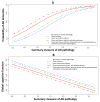Relation of cerebral vessel disease to Alzheimer's disease dementia and cognitive function in elderly people: a cross-sectional study
- PMID: 27312738
- PMCID: PMC4969105
- DOI: 10.1016/S1474-4422(16)30029-1
Relation of cerebral vessel disease to Alzheimer's disease dementia and cognitive function in elderly people: a cross-sectional study
Abstract
Background: Few data on the pathology of cerebral vessel disease, dementia, and cognition are available. We examined the association of cerebral atherosclerosis and arteriolosclerosis neuropathology with probable and possible Alzheimer's disease dementia and cognitive function.
Methods: This cross-sectional study included men and women aged 65 years or older who had yearly clinical assessments and had agreed to brain autopsy at the time of death, as part of one of two cohort studies of ageing (The Religious Orders Study and the Rush Memory and Aging Project). Individuals without dementia or with Alzheimer's disease dementia, and with complete neuropathological data, are included in our analyses. We used neuropsychological data proximate to death to create summary measures of global cognition and cognitive domains. Clinical data recorded between 1994 and 2015 were used to determine presence of Alzheimer's disease dementia. Systematic neuropathological assessments documented the severity of cerebral large vessel (atherosclerosis) and small vessel (arteriolosclerosis) disease. By use of regression analyses adjusted for demographics, gross and microscopic infarcts, and Alzheimer's disease pathology, we examined associations of vessel disease severity (mild, moderate, and severe) with odds of probable and possible Alzheimer's disease dementia and cognitive function.
Findings: Study enrolment began in January, 1994, and two cohort studies are ongoing. 1143 individuals were included in our analyses (median age at death 88·8 years; 478 [42%] with Alzheimer's disease dementia). Moderate-to-severe atherosclerosis was present in 445 (39%) individuals, and arteriolosclerosis in 401 (35%) individuals. Each level increase in the severity of atherosclerosis or arteriolosclerosis was associated with significantly higher odds of Alzheimer's disease dementia (odds ratio [OR] for atherosclerosis 1·33, 95% CI 1·11-1·58; OR for arteriolosclerosis 1·20, 1·04-1·40). Atherosclerosis was associated with lower scores for global cognition (estimate -0·10 [SE 0·04], p=0·0096) and four cognitive domains (episodic memory -0·10 [0·04], p=0·017; semantic memory -0·11 [0·05], p=0·018; perceptual speed -0·14 [0·04], p=0·00080; and visuospatial abilities -0·13 [0·04], p=0·0080), but not working memory (-0·05 [0·04], p=0·21). Arteriolosclerosis was associated with lower scores for global cognition (estimate -0·10 [0·03], p=0·0015) and four domains (episodic memory -0·12 [0·04], p=0·00090; semantic memory -0·10 [0·04], p=0·013; working memory -0·07 [0·03], p=0·045; perceptual speed -0·12 [0·04], p=0·0012), and a non-significant association was noted for visuospatial abilities (-0·07 [0·03], p=0·052). Findings were unchanged in analyses controlling for the presence of APOE ε4 allele or vascular risk factors.
Interpretation: Cerebral atherosclerosis and arteriolosclerosis are associated with Alzheimer's disease dementia, and are also associated with low scores in most cognitive domains. Cerebral vessel pathology might be an under-recognised risk factor for Alzheimer's disease dementia.
Funding: US National Institutes of Health.
Copyright © 2016 Elsevier Ltd. All rights reserved.
Conflict of interest statement
Dr. Arvanitakis reports grants from United States National Institutes of Health and grants from Illinois Department of Public Health, during the conduct of the study. Dr. Bennett reports grants from the United States National Institutes of Health and grants from Illinois Department Public Health, during the conduct of the study. Dr. Schneider reports personal fees from AVID Radiopharmaceuticals and personal fees from Navidea Biopharmaceuticals, outside the submitted work.
Figures


Comment in
-
Cerebrovascular pathology and Alzheimer's disease.Lancet Neurol. 2016 Aug;15(9):895-896. doi: 10.1016/S1474-4422(16)30038-2. Epub 2016 Jun 14. Lancet Neurol. 2016. PMID: 27312739 Free PMC article. No abstract available.
References
-
- World Health Organization. Fact Sheet No 310, Updated May 2014. [accessed January 13, 2016];The 10 leading causes of death in the world, 2000 and 2012. http://www.who.int/mediacentre/factsheets/fs310/en/
-
- White L, Petrovitch H, Hardman J, et al. Cerebrovascular pathology and dementia in autopsied Honolulu-Asia Aging Study participants. Ann N Y Acad Sci. 2002 Nov;977:9–23. - PubMed
-
- Hofman A, Ott A, Breteler MM, Bots ML, et al. Atherosclerosis, apolipoprotein E, and prevalence of dementia and Alzheimer’s disease in the Rotterdam Study. Lancet. 1997 Jan 18;349(9046):151–4. - PubMed
-
- van Exel E, Gussekloo J, Houx P, et al. Atherosclerosis and cognitive impairment are linked in the elderly. The Leiden 85-plus Study. Atherosclerosis. 2002 Dec;165(2):353–9. - PubMed
-
- Bos D, Vernooij MW, Elias-Smale SE, et al. Atherosclerotic calcification relates to cognitive function and to brain changes on magnetic resonance imaging. Alzheimers Dement. 2012 Oct;8(5 Suppl):S104–11. - PubMed
Publication types
MeSH terms
Grants and funding
LinkOut - more resources
Full Text Sources
Other Literature Sources
Medical
Miscellaneous

